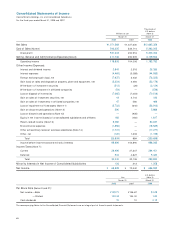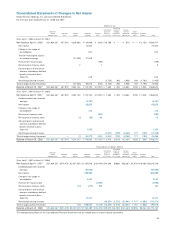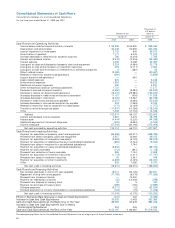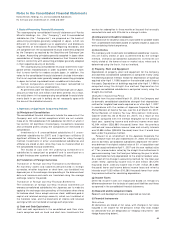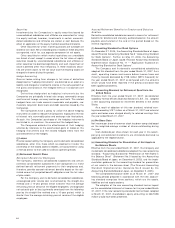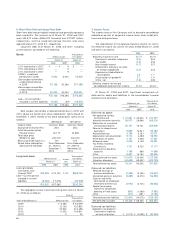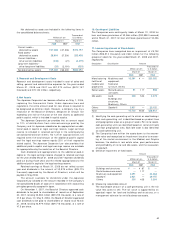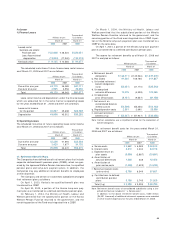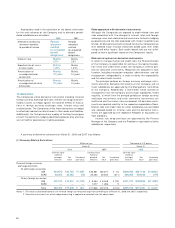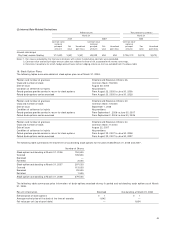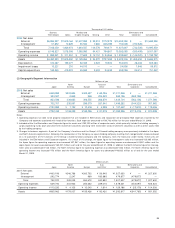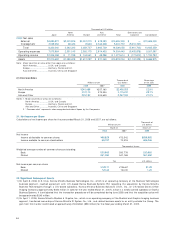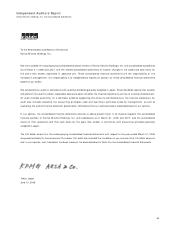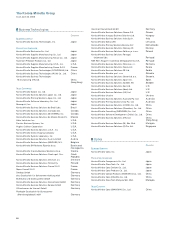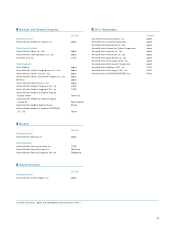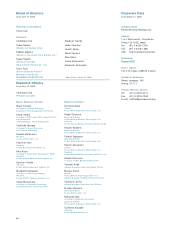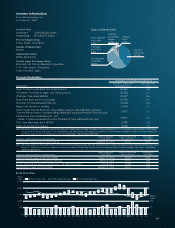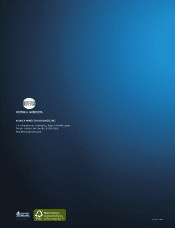Konica Minolta 2008 Annual Report Download - page 53
Download and view the complete annual report
Please find page 53 of the 2008 Konica Minolta annual report below. You can navigate through the pages in the report by either clicking on the pages listed below, or by using the keyword search tool below to find specific information within the annual report.
50
A summary of derivative instruments at March 31, 2008 and 2007 is as follows:
(1) Currency-Related Derivatives
Millions of yen Thousands of U.S. dollars
March 31 March 31
2008 2007 2008
Contract value Contract value Contract value
(notional (notional (notional
principal Fair Unrealized principal Fair Unrealized principal Fair Unrealized
amount) value gain (loss) amount) value gain (loss) amount) value gain (loss)
Forward foreign currency
exchange contracts:
To sell foreign currencies:
US$ ¥34,670 ¥32,782 ¥ 1,887 ¥36,861 ¥36,817 ¥ 44 $346,043 $327,198 $ 18,834
EURO 30,954 30,983 (28) 25,352 25,664 (311) 308,953 309,242 (279)
To buy foreign currencies:
US$ ¥15,103 ¥13,912 ¥(1,191) ¥ 8,354 ¥ 8,508 ¥ 153 $151,013 $138,856 $(11,887)
EURO ———1,277 1,286 9 ———
Total ¥80,729 ¥77,678 ¥ 667 ¥71,846 ¥72,276 ¥(104) $805,759 $775,307 $ 6,657
Notes: 1. Fair value is calculated based on the forward foreign currency exchange rates prevailing as of March 31, 2008 and 2007, respectively.
2. Derivative instruments for which hedge accounting is applied are excluded from the above table.
Assumptions used in the calculation of the above information
for the main schemes of the Company and its domestic consoli-
dated subsidiaries are as follows:
2008 2007
Method of attributing Periodic Periodic
retirement benefits allocation allocation
to periods of service method method
for projected for projected
benefit benefit
obligations obligations
Discount rate Mainly Mainly
2.5% 2.5%
Expected rate of return Mainly Mainly
on plan assets 1.25% 1.25%
Amortization of Mainly Mainly
unrecognized prior 10 years 10 years
service cost
Amortization of Mainly Mainly
unrecognized actuarial 10 years 10 years
differences
18. Derivatives
The Companies utilize derivative instruments including forward
foreign currency exchange contracts, interest rate swaps and com-
modity futures, to hedge against the adverse effects of fluctua-
tions in foreign currency exchange rates, interest rates and
material prices. The Companies utilize these derivatives as hedges
to effectively reduce the risks inherent in their assets and liabilities.
Additionally, the Companies have a policy of limiting the purpose
of such transactions to hedging identified exposures only and they
are not held for speculative or trading purposes.
Risks associated with derivative instruments
Although the Companies are exposed to credit-related risks and
risks associated with the changes in interest rates and foreign
exchange rates, such derivative instruments are limited to hedging
purposes only and the risks associated with these transactions are
limited. All derivative contracts entered into by the Companies are
with selected major financial institutions based upon their credit
ratings and other factors. Such credit-related risks are not antici-
pated to have a significant impact on the Companies’ results.
Risk control system for derivative instruments
In order to manage market and credit risks, the Finance Division
of the Company is responsible for setting or managing the posi-
tion limits and credit limits under the Company’s internal poli-
cies for derivative instruments. Resources are assigned to each
function, including transaction execution, administration, and risk
management, independently, in order to clarify the responsibility
and the role of each function.
The principal policies on foreign currency exchange instru-
ments and other derivative instruments of the Company and its
major subsidiaries are approved by the Management Committee
of the Company. Additionally, a Committee, which consists of
management from the Company and its major subsidiaries, meets
regularly, at which time the principal policies on foreign currency
exchange instruments and other derivative instruments are
reaffirmed and the market risks are assessed. All derivative instru-
ments are reported monthly to the respective responsible officers.
Market risks and credit risks for other subsidiaries are controlled
and assessed based on internal rules and the derivative instru-
ments are approved by the respective President or equivalent of
each subsidiary.
Interest rate swap contracts are approved by the Finance
Manager of the Company and the President or equivalent of other
subsidiaries, respectively.


